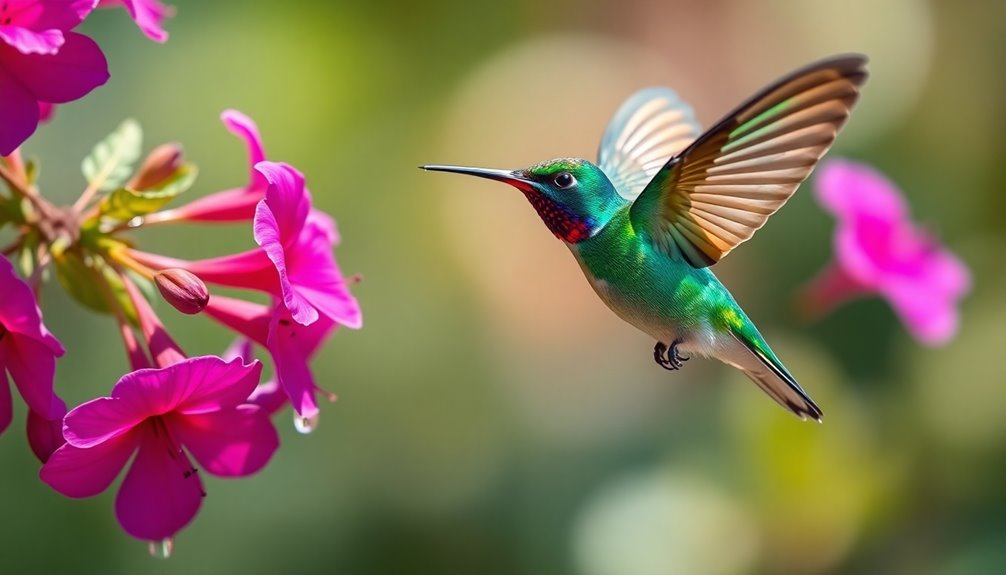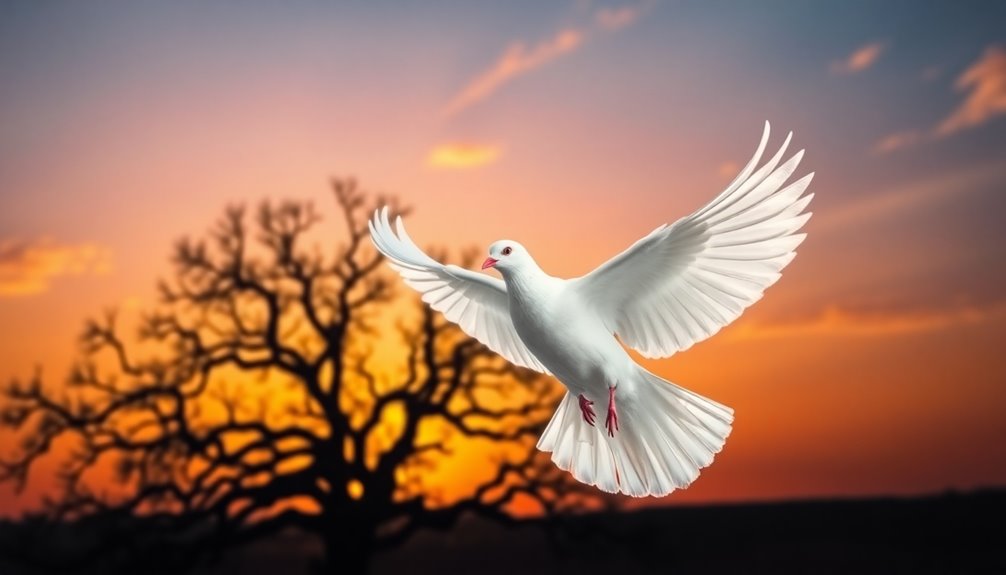Hummingbirds are amazing symbols of joy, beauty, and resilience. In many cultures, they're seen as spirit animals that bring good luck and positive energy. Myths tell stories of hummingbirds as messengers from the spirit world, spreading gratitude and love. These tiny birds show us how important it is to appreciate the little things in life, like moments of happiness and connection with nature. They also inspire creativity and remind us to heal from challenges. You might be surprised to learn just how much these vibrant creatures can teach us about life and joy!
Key Takeaways
- Hummingbirds symbolize joy, beauty, and positive energy in various cultures, particularly in Indigenous traditions.
- They serve as spiritual messengers, representing life changes, gratitude, and celebrations in Native American mythology.
- The symbolism of hummingbirds includes resilience and healing, reflecting the ability to overcome challenges.
- In art and literature, hummingbirds embody fleeting happiness, love, and the appreciation of simple pleasures.
- Their vibrant nature and ecological role highlight the importance of connecting with nature and nurturing relationships.
Cultural Significance of Hummingbirds
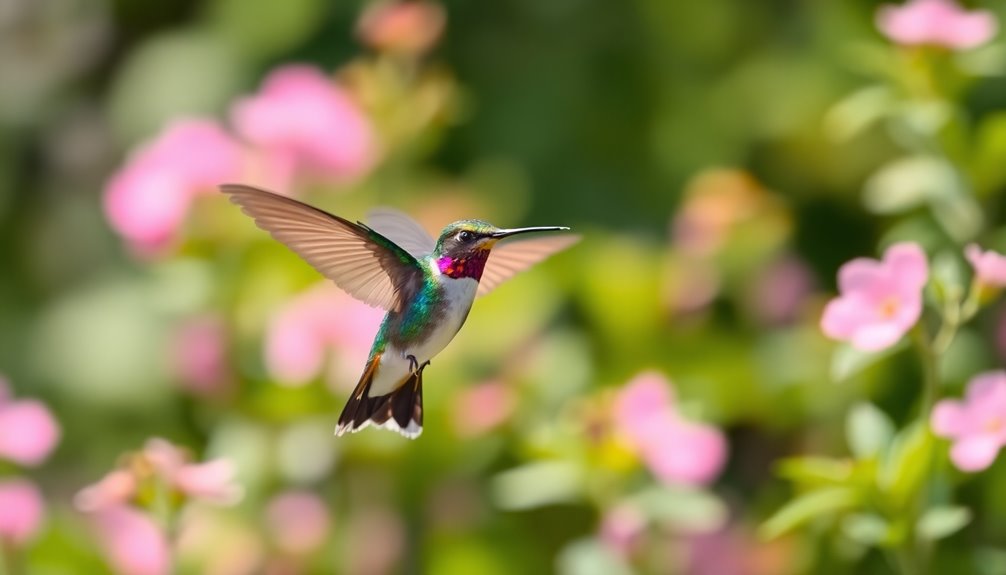
Hummingbirds hold deep cultural significance across various Indigenous communities, embodying joy and beauty in their vibrant existence.
These little birds are often seen as spirit animals, representing good luck and positive energy. In many Indigenous cultures, they symbolize love and the importance of living in the moment.
For instance, on the Pacific Coast, hummingbirds are respected for their intelligence and fierce territorial defense. Before hunting trips, people consider them good luck omens.
The Haida culture even adorned high-ranking women's hair with live hummingbirds, reflecting their status and prestige.
You might notice that many artistic representations of hummingbirds highlight their beauty, showcasing their large heads and bright eyes in connection with flowers.
This art emphasizes the hummingbird's role as a messenger, linking nature and spirituality.
In various legends, such as the one where Raven transforms a flower into a hummingbird, these creatures are seen as important connectors between the earthly and spiritual domains.
Mythological Origins and Stories

The rich cultural significance of hummingbirds naturally leads to their prominent role in mythological stories across Indigenous communities. In Native American mythology, these tiny birds are seen as messengers of the spirit world. They connect nature and spirituality, delivering important messages between dimensions. Imagine a hummingbird totem, representing beauty and good luck, fluttering around to share wisdom.
In one legend, the Raven transformed a flower into a hummingbird, tasking it with spreading gratitude for nature's beauty. Hummingbirds are also viewed as symbols of warriors in Central American tales, carrying messages from gods to people. This makes them powerful figures in mythology!
The Haida culture holds hummingbirds in high regard, respecting them as fierce fighters and territorial defenders. When you spot a hummingbird, it's not just a beautiful sight; it could be a sign of good luck, especially before significant events like hunting trips.
These stories remind us how much these little birds live in our hearts and imaginations, weaving connections between our world and the mysteries beyond. Every flap of their wings carries tales of strength, beauty, and the spirit of nature.
Symbolism and Spiritual Meanings

Often, you'll find that hummingbirds carry deep symbolism and spiritual meanings across various cultures.
They're not just beautiful creatures; they remind us to live joyfully and appreciate the present moment. Their vibrant colors and energy encourage us to find beauty in everyday life, even when times are tough.
Here are some powerful meanings associated with the hummingbird spirit:
- Joy and Positivity: They symbolize happiness and the importance of staying upbeat.
- Resilience and Healing: Hummingbirds embody the strength to recover from challenges.
- Spiritual Messengers: Encounters often signify important life changes or celebrations.
- Love and Freedom: They emphasize nurturing relationships with loved ones.
- Creativity: Their agility inspires us to think outside the box and solve problems uniquely.
When a hummingbird visits, it's like a reminder that life is full of possibilities. Their ability to fly backwards teaches us to look back and learn from past experiences while moving forward. Additionally, embracing practices like self-care and mindfulness can enhance our ability to appreciate these moments and cultivate joy in our lives.
Hummingbirds in Art and Literature
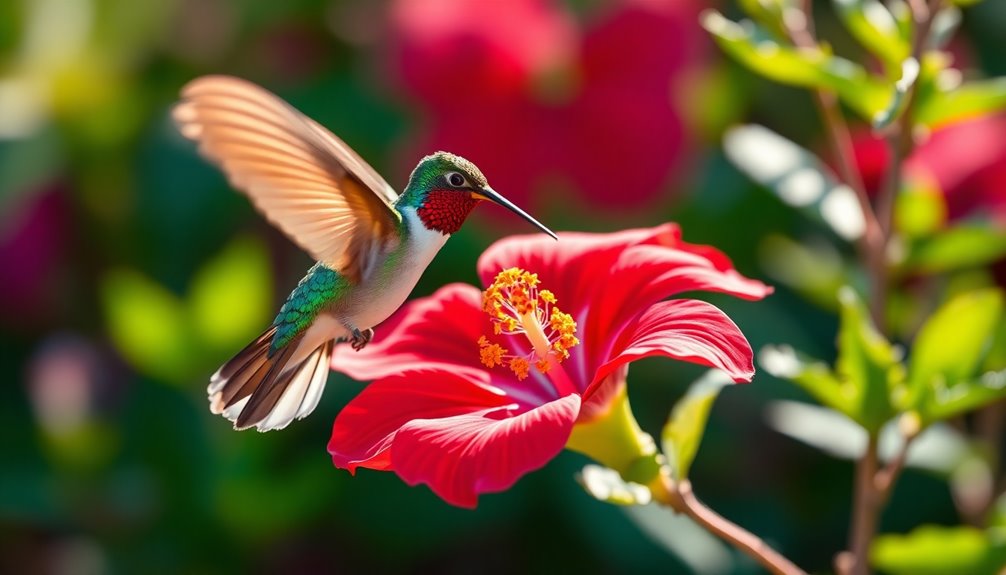
In art and literature, hummingbirds capture our imagination with their vibrant beauty and dynamic presence. These tiny creatures symbolize joy, healing, and the freedom to explore nature. Artists and writers often showcase hummingbirds to express deep emotions and themes.
Here's a table to help you see how hummingbirds inspire creativity:
| Aspect | Symbolism |
|---|---|
| Art | Beauty, grace, and liveliness |
| Native American | Love, joy, and healing |
| Literature | Fleeting moments of happiness |
| Contemporary Art | Positivity, hope, and resilience |
When you look at a painting or read about a hummingbird, you might feel a sense of joy or peace. Their swift movements and colorful feathers remind us to appreciate life's simple pleasures. In many cultures, they're seen as spiritual messengers, encouraging us to connect with our emotions and each other.
Contemporary Relevance and Interpretation
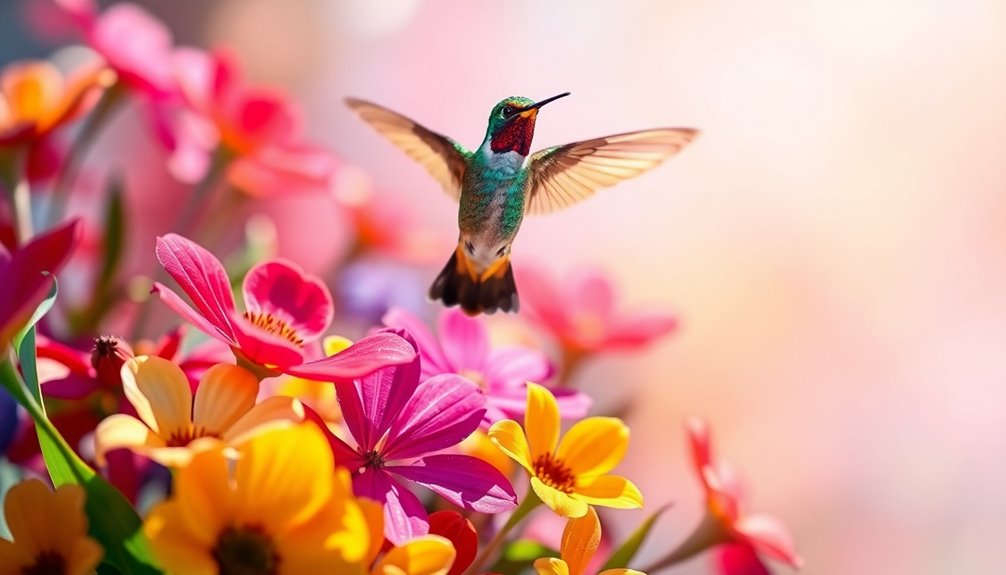
Hummingbirds resonate with audiences today, symbolizing joy and positivity across various mediums. These tiny creatures have become powerful symbols, reflecting their significance in Indigenous cultures and modern life. Their vibrant colors and energetic nature make them a favorite in art and jewelry, bringing happiness to those who admire them.
Here are some exciting ways hummingbirds inspire us today:
- Joy: Their playful movements remind us to find happiness in everyday life.
- Positivity: Hummingbirds encourage a hopeful outlook, even during tough times.
- Spirituality: They often symbolize the importance of connecting with nature and our inner selves.
- Gratitude: Observing these birds teaches us to appreciate fleeting moments.
- Ecological Importance: Hummingbirds play a vital role in our ecosystems, pollinating plants and supporting biodiversity. This connection to nature parallels the care we must show to our large indoor plants, which also contribute to our environment.
With the rise of birdwatching technologies, you can connect with hummingbirds like never before. Educational initiatives also promote their symbolism in Indigenous cultures, deepening our understanding.
Frequently Asked Questions
What Is the Spiritual Meaning of Seeing a Hummingbird?
Seeing a hummingbird can feel like a special gift! It often carries a spiritual meaning, reminding you to embrace joy and positivity in your life.
When you spot one, it might be a sign to appreciate the beauty around you and be open to change.
Hummingbirds can also symbolize healing, encouraging you to stay resilient.
Their vibrant presence may even bring comfort, reminding you that loved ones are always with you in spirit.
What Is the Biblical Meaning of Seeing a Hummingbird?
When you see a hummingbird, it can feel special!
In the Bible, these little birds symbolize joy, love, and positivity. Their quick movements remind you to enjoy life's small blessings and stay focused on the present.
Hummingbirds also encourage you to reflect on your past while moving forward. Spotting one might feel like receiving a message of hope, urging you to keep the faith and persevere through life's challenges.
Isn't that uplifting?
What Does It Mean When You Start Seeing Hummingbirds?
When you start seeing hummingbirds, it can feel magical!
These tiny birds often show up during important moments in your life. They might mean you're entering a time of healing or joy.
Seeing them could also remind you to appreciate the little things and embrace happiness.
Sometimes, they symbolize a loved one's spirit nearby, offering comfort and love.
Are Hummingbirds Messengers From Heaven?
You might wonder if hummingbirds are messengers from heaven. Many people believe they are!
When you see a hummingbird, it can feel like a special sign. Some think they bring messages of hope and healing, especially during tough times.
Their quick movements and bright colors often lift spirits. So, if a hummingbird flits by, it could mean a loved one is watching over you, sending joy and love your way!
Conclusion
To sum up, hummingbirds are like little messengers of joy and wonder! They remind us of the beauty in life's fleeting moments. With their vibrant colors and swift movements, they spark excitement in our hearts. From ancient myths to modern art, these delightful creatures symbolize love, happiness, and resilience. So, the next time you see a hummingbird, take a moment to appreciate its magic and the special meanings it brings into our lives!

